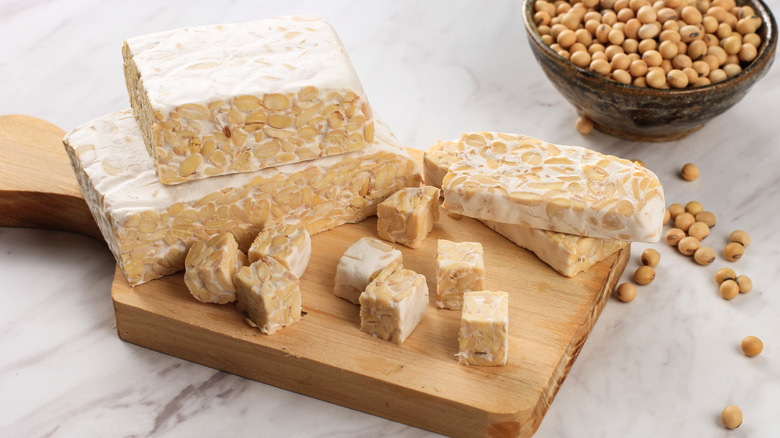The Biggest Difference Between Seitan And Tempeh
For vegans and those looking to cut out meat, there are plenty of protein alternatives such as lentils, beans, nuts, seeds, and tofu. Seitan and tempeh also rank among these as well. While they both are plant-based sources of protein, they're actually very different from each other in both texture and the ways they're prepared. Much like tofu, tempeh is made from soybeans except, in this case, the soybeans are fermented and compressed into dense blocks. Fermentation gives tempeh nutty and earthy flavors of its own that distinguish it from tofu.
Seitan, on the other hand, comes from an entirely different plant. Pronounced as say-tawn or say-tan, seitan also goes by the name of vital wheat gluten and is made by washing wheat flour dough until all the starch is gone, leaving only its gluten behind. While this makes seitan more pliable than tempeh to be molded into different shapes, there is one advantage that tempeh has over seitan. Tempeh contains all nine essential amino acids and is thus considered a complete protein like meat, according to SFGate, whereas seitan lacks at least one amino acid and so, isn't considered a complete protein (via Vegan's First).
How to prepare seitan and tempeh
Because of the way they are made, the texture of tempeh and seitan greatly varies as do their preparations. Tempeh has a firm and dense texture. According to Food Network, tempeh is ideal for stir-frying, baking, grilling, and frying where you want thin strips or cubes of tempeh to hold their shape whilst crisping up under the heat.
Unlike tempeh's firmness, seitan has a chewy texture and can be molded into different shapes. Seitan is also closer in texture to actual meat than tempeh which is why it is often referred to as wheat meat, according to Thrillist. This makes seitan the go-to protein of choice to make plant-based alternatives for traditionally meaty dishes like chicken wings, nuggets, meatballs, ribs, and the like. As for their countries of origin, seitan originates from China while tempeh comes from Indonesia.
Overall, because of its texture and pliability, seitan is mostly preferred by those who want their plant-based proteins to be the closest to actual meat. Meanwhile, you can use tempeh if you want the opposite. Additionally, seitan is not suitable for those with gluten intolerance, and tempeh isn't ideal for anybody with soy allergies. So keep that in mind when preparing.

